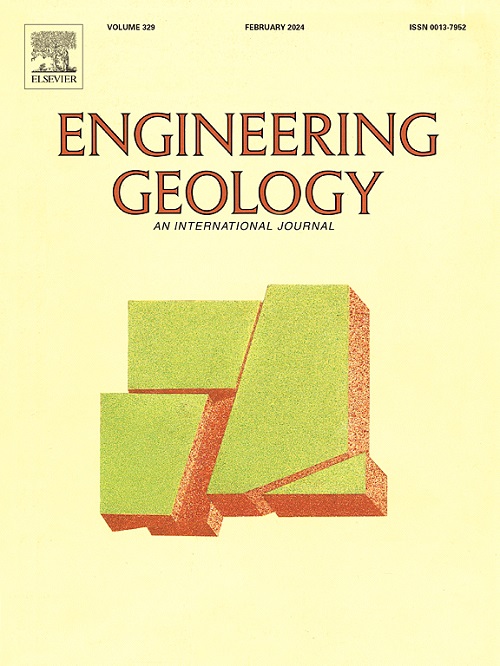人工冻结过程中珊瑚钙质砂中冻结和未冻结水分含量的估算
IF 6.9
1区 工程技术
Q1 ENGINEERING, GEOLOGICAL
引用次数: 0
摘要
在盛产珊瑚钙质砂的热带地区,施工过程中经常会采用人工冷冻技术。然而,人们对钙质砂在冻结条件下的基本热力学行为和水分动态了解甚少。因此,我们进行了实验室测试,并开发了一个数值模型来捕捉人工冷冻过程中钙质砂的总水分、液态水和冰含量。研究中使用了热光纤布拉格光栅(T - FBG)和频域反射仪方法。考虑到初始含水量和环境温度,对冻结特性曲线进行了定量分析。结果表明,T - FBG 能有效估算未冻结和冻结钙质砂中的总含水量以及冻结土壤中的含冰量,误差小于 0.029 立方米/立方米。T - FBG 加热引起的冰融化受初始含水量、加热持续时间、功率和环境温度的影响。不过,最大变化低于 0.008 立方米/立方米,可以忽略不计。van Genuchten 模型准确地描述了非饱和钙质砂的液体湿度-温度关系,R2 超过 0.98。残余-初始含水量关系遵循二次函数。在冻结过程中,温度降低与 Kozlowski 模型一致,液体湿度-温度关系遵循三次多项式函数。本文章由计算机程序翻译,如有差异,请以英文原文为准。
Frozen and unfrozen moisture content estimation in coral calcareous sand during artificial freezing
In tropical areas where coral calcareous sands are prevalent, artificial freezing techniques are frequently employed during construction. However, the fundamental thermodynamic behaviors and moisture dynamics of calcareous sands under freezing conditions are poorly understood. Therefore, we conducted laboratory tests and developed a numerical model to capture the total moisture, liquid water, and ice contents of calcareous sand during artificial freezing. The thermal fiber Bragg grating (T − FBG) and frequency − domain reflectometry methods were used in the study. Freezing characteristic curves were quantitatively analyzed with taking into account the initial moisture content and ambient temperature. The results indicate that T − FBG effectively estimates the total moisture content in unfrozen and frozen calcareous sand, as well as ice content in frozen soil, with less than 0.029 m3/m3 error. Ice melting induced by T − FBG heating is affected by the initial moisture content, heating duration, power, and ambient temperature. However, the maximum change is below 0.008 m3/m3, which is negligible. The van Genuchten model accurately describes the liquid moisture–temperature relationship of unsaturated calcareous sand, with an R2 exceeding 0.98. The residual–initial moisture content relationship follows a quadratic function. During freezing, the temperature reduction aligns with the Kozlowski model, and the liquid moisture–temperature relationship follows a cubic polynomial function.
求助全文
通过发布文献求助,成功后即可免费获取论文全文。
去求助
来源期刊

Engineering Geology
地学-地球科学综合
CiteScore
13.70
自引率
12.20%
发文量
327
审稿时长
5.6 months
期刊介绍:
Engineering Geology, an international interdisciplinary journal, serves as a bridge between earth sciences and engineering, focusing on geological and geotechnical engineering. It welcomes studies with relevance to engineering, environmental concerns, and safety, catering to engineering geologists with backgrounds in geology or civil/mining engineering. Topics include applied geomorphology, structural geology, geophysics, geochemistry, environmental geology, hydrogeology, land use planning, natural hazards, remote sensing, soil and rock mechanics, and applied geotechnical engineering. The journal provides a platform for research at the intersection of geology and engineering disciplines.
 求助内容:
求助内容: 应助结果提醒方式:
应助结果提醒方式:


